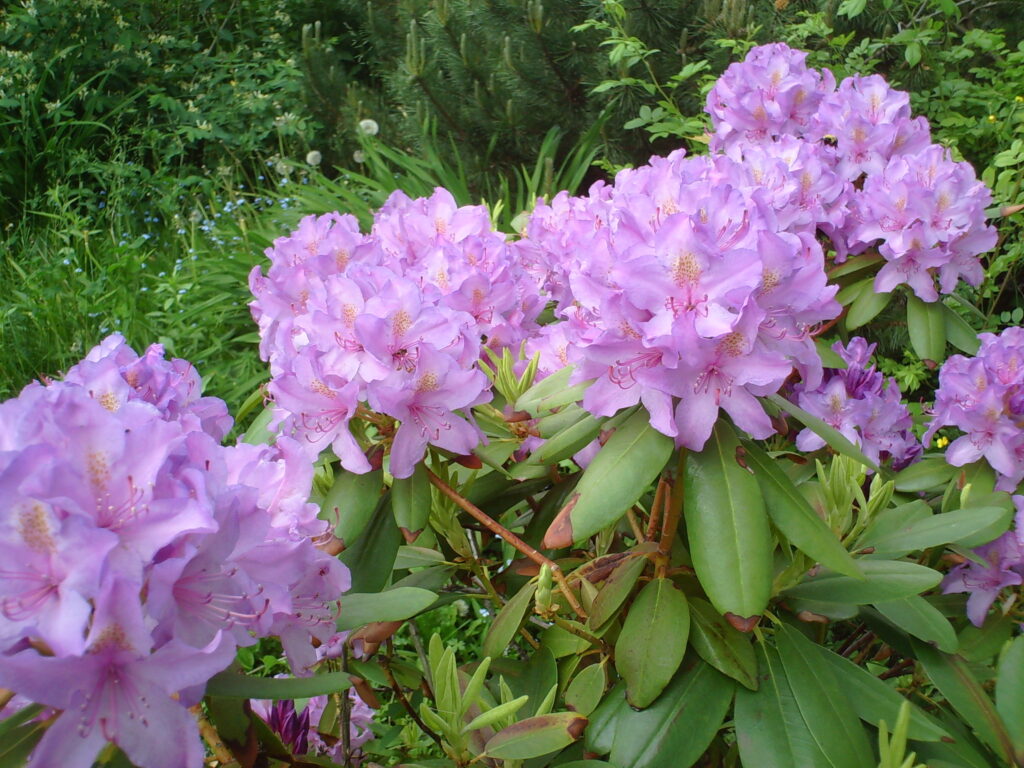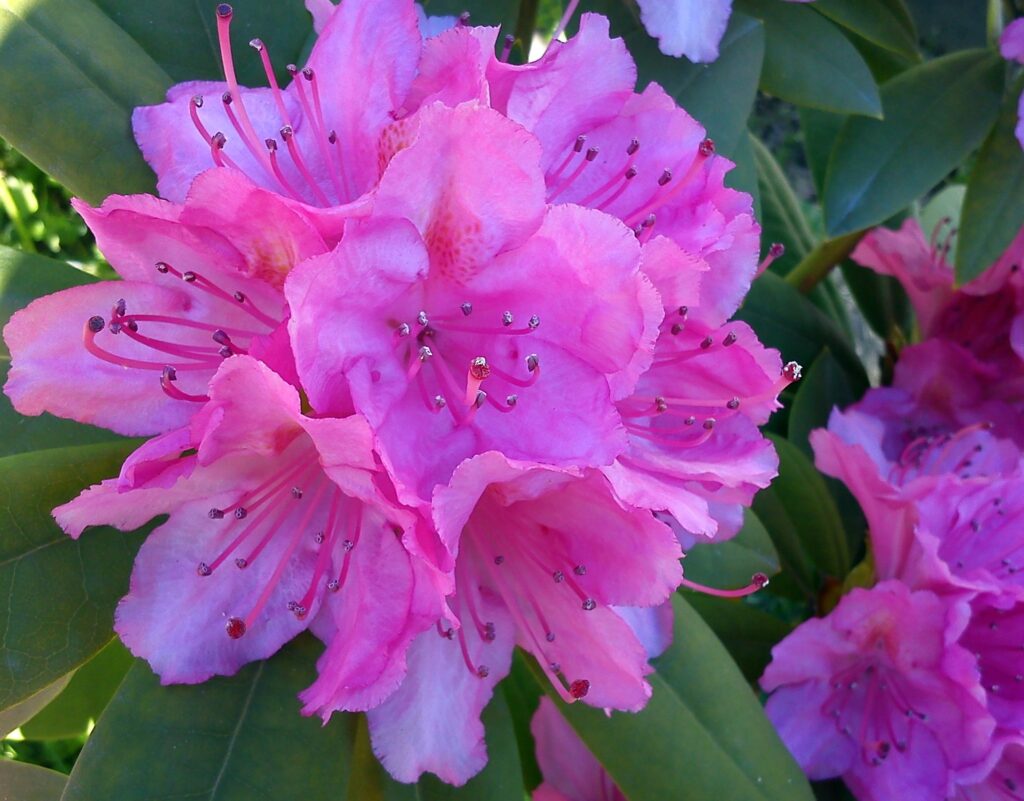Rhododendrons, in the Ericaceae family of plants, are native to Asia, Europe, North America, and Australia. They are most prized today for their beautiful flowers. They have been cultivated in Europe and Asia since the 1600s. Native Americans harvested the leaves to treat inflammation. Herbalists still commonly use the leaves in poultices for the same reason. These beautiful shade-loving flowering shrubs are grown and loved all over the world. There are literally hundreds of different species. They are grown in many different ways, but they are easy to grow into flowered hedges, planted along the edge of a garden as a border, or in containers!

Types of Rhododendrons
The main categories of rhododendrons are evergreen rhododendron shrubs, deciduous rhododendron shrubs, and rhododendron trees (also evergreen). Azaleas are a specific variety of rhododendron but are different from the main family enough that they have their own rules for care. Evergreen rhododendrons are a good way to keep spots of green in your garden over winter. The deciduous varieties will lose their leaves in the winter, but both types are perennials and will come back strong in the spring.
- Rhododendron
- Perennial
- Partial Shade to Full Sun
- Moist and well-drained acidic soil (4.5-6.0 pH).
- Start seedlings or cuttings indoors in the late fall.
- Plant in the garden 2 weeks after the last frost in spring.
- Plant 48″ apart for healthy shrubs.
- Growing in containers:
Start single plants in at least 12″ deep, and 16″ wide pots
The pot should be about as wide as the foliage, move to a larger pot as it grows
Ensure good drainage and acidic soil
- Water regularly, keeping the soil moist.
- Climate Zones 6-9 for evergreen varieties
- Climate Zones 4-9 for deciduous varieties
How to Plant Rhododendrons
Plant rhododendrons in the spring after the last frost, or in early fall. The plants start dormancy in the fall and come out of their dormant phase in the spring. In colder climates, plant rhododendrons in the spring. A fall planting will still work in many cases, especially if precautions are taken, but the young plants are sensitive to winter freezes. In warmer climates, fall planting is best. The distance between each plant should be about four feet (48 inches) unless the variety you are planting will be much larger or smaller than that. Plant them in a hole about as deep as the roots, and about twice as wide, and fill in with healthy organic soil, with some compost. For climates that are in between hot and cold, planting any time of year can work but spring is still probably best.

The location of the plant in relation to the sun, the soil, and shelter from wind are a few of the most important factors in deciding where to plant rhododendrons. Herbaceous rhododendrons with larger leaves especially need sun for part of the day and shade for the remainder of the day, or dappled sunlight throughout the day. Evergreen rhododendrons can tolerate more sun but also prefer partial shade. If you can, plant on the north side of a structure (like your house, or an outbuilding) so that they will get shade for part of the day, especially in warmer climates.
The soil should be somewhat acidic, rhododendron does not do well in alkaline soils. Good drainage is needed, and the soil should be rich and fertile. If a lot of clay soil is present, it’s best to dig out around the base of the plant when planting, put in more loamy soil, or amend the soil to help with drainage. Ensure that these shallow-rooted plants are planted near the surface, and have moist soil, not too dry or too wet. In areas that get a lot of wind in the winter or if a storm is expected in any season, it’s best to create some shelter, or a windbreak, around the plant, to help avoid wind damage.
These beautiful flowering shrubs are really easy to grow, the main things to remember are: make sure that the soil drains well and doesn’t get too wet, plant them where they get some light and some shade, and use straw or shredded bark as mulch in the winter to protect the shallow roots from the cold!
Growing Rhododendrons in Containers
They do very well in the garden but are also great in containers. Due to their shallow root system they are well suited for containers, just be careful that the pot is wide enough. The final pot should be about as wide as the plant at full growth. It’s pretty easy to transplant small rhododendrons, so it’s okay to start them in small pots and move them to larger pots. Containers allow great control over the soil type and over available light. The right pot will help ensure good drainage too!

Witch-hazel is a good companion for rhododendrons. This is an herb that blooms in the winter. It can be a good contrast to the rhododendron’s dormant cold season. Hostas and ferns also provide a good contrast with this plant, and all can thrive in similar conditions. Other plants tolerant of or needing acidic soil will do well as companions. It’s good to plant rhododendrons underneath oak trees, as these have deep roots, and this pairs well with the shallow-rooted rhododendron plants. Oaks will also provide dappled shade that these plants love. Don’t plant them near black walnut trees, though. A substance called juglone is secreted by black walnuts, and it’s toxic to these plants (among others).
Rhododendron Pests and Diseases
Rhododendrons are susceptible to a few fungal diseases: Leaf Spot and Root Rot. The fungal leaf spot is not too serious. The symptoms are dead spots in a random pattern on the leaves of the plant. Infected leaves can be trimmed from the plant and disposed of. Root rot is more of a problem for this shallow-rooted flower. There really is no treatment that will address this, and infected plants should be removed and disposed of, and not composted. A major cause is poor drainage. Bad infections may need the soil to be treated with a fungicide. Root rot can be prevented by picking up fallen leaves, even healthy fallen leaves, from around the base of the plant. In autumn, don’t use the rhododendron leaves as your mulch!
Too much water or not enough water can also cause problems. If the roots absorb too much water it won’t be able to be used by the plant. That is an issue especially in humid climates because high humidity inhibits the ability of the water to be “transpired,” or evaporated from the leaves. “Winter injury” caused by drying is the opposite problem. The roots can’t absorb as much water from the cold soil, and the dry weather will remove water from the leaves of the plant more quickly. Mulching keeps the soil warmer and helps a lot with this problem.
These woody perennials will only rarely have pest problems. There are a few pests specific to this plant: Rhododendron borers, lace bugs, and midges will cause leaf damage and are more common along the east coast of the United States. A few kinds of weevils can also be a problem, causing damage to the roots. These bugs are in the northern regions of the US.
Rhododendrons can be propagated in your home garden in a number of ways. Seed pods can be gathered in the fall, the seeds gathered and dried, and germinated in the late winter by scattering them over some acidic potting soil, like perlite mixed with peat moss. Kept a bit humid and well-lighted, they will usually germinate in a few weeks, sometimes a bit longer. These seedlings can be transplanted to containers or directly into the garden, a bit after the last frost. Cuttings will work, but layering is easier. Layering is taking an existing branch, cutting into it vertically, and planting that part with the main branch still attached to the plant. Keep it there for a few years, and it will sprout roots. The new plant can then be separated from the parent plant and transplanted.
Some simple care and easy steps will give you some beautiful flowering shrubs that will last your lifetime! If you’re growing rhododendrons in your garden, share some garden photos in our community!











